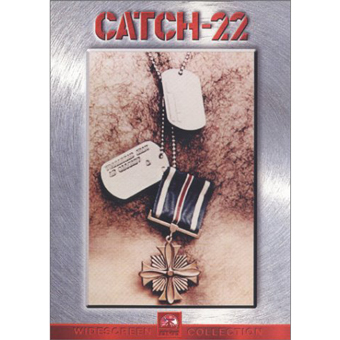CATCH-22
(director: Mike Nichols; screenwriters: Buck Henry/from the book by Joseph Heller; cinematographer: David Watkin; editor: Sam O’Steen; music: Fritz Reiner; cast: Alan Arkin (Capt. John Yossarian), Martin Balsam (Col. Cathcart), Richard Benjamin (Maj. Danby ), Art Garfunkel (Capt. Nately), Jack Gilford (Dr. ‘Doc’ Daneeka), Buck Henry (Lt. Col. Korn), Bob Newhart (Maj. Major Major Major), Anthony Perkins (Chaplain Capt. A.T. Tappman), Paula Prentiss (Nurse Duckett), Martin Sheen (1st Lt. Dobbs), Jon Voight (1st Lt. Milo Minderbinder), Orson Welles (Brig. Gen. Dreedle), Susanne Benton (Dreedle’s WAC), Bob Balaban (Capt. Orr), Norman Fell (First Sgt. Towser), Charles Grodin (Aardvark); Runtime: 121; MPAA Rating: R; producers: John Calley/Martin Ransohoff; Paramount; 1970)
“Still positively chilling.”
Reviewed by Dennis Schwartz
Based on Joseph Heller’s impossible to film satirical antiwar WW11 film, as written by Buck Henry and directed by Mike Nichols (“The Graduate”/”Who’s Afraid of Virginia Woolf?”). It never caught on with the public (or, for that matter, with many film critics except as a flawed work with some good spots) and served as Nichols’ first box office disaster. Unable to tell the whole story in terms of a cinema experience, Nichols settles for various set-pieces that revolve around the recurring nightmare plaguing bomber pilot Captain Yossarian (Alan Arkin). He’s the neurotic flyer who is afraid to fly anymore and is trying to get grounded because he’s crazy. But he’s informed by the glum base doctor, Daneeka (Jack Gilford), that according to the military code “anyone who wants to get out of combat isn’t really crazy and therefore can’t be grounded.” That double-talk forms the paradoxical bind interpreted as an impossible military snafu, which serves as the film’s “catch-22” (now part of the lexicon). The set-pieces often don’t work separated from the whole story, as the absurdity of the “catch-22” situation that prevails in the book gets lost for the most part in the overlong and fractured narrative. What helps is the all-star ensemble cast pitches in with spirited performances and at least gives the viewer some glimpses at how hilarious and wonderful the book was.
The film is framed after the opening incident when Yossarian has been stabbed by an enemy P.O.W. and in a delirious state is having a nightmare recalling his military actions that led him not to play ball with the corrupt system and instead go AWOL. Set in a United States Air Force base on the Mediterranean island of Pianosa, where Colonel Cathcart (Martin Balsam) runs the base and makes it impossible for the pilots to be relieved of duty as he keeps raising the number of missions the men have to fly before they are rotated. The Colonel is a publicity hound whose chief desire is to be featured in The Saturday Evening Post. His underling, Lt. Col. Korn (Buck Henry), is an evil, obsequious “yes man.” Some of the other colorful characters portrayed include: the despotic General Dreedle (Orson Welles) who demands his orders, no matter how absurd, be followed to the letter, and when disobeyed we see where he commands his underlings to “Take him out and shoot him;” Captain Orr (Robert Balaban), who has crash-landed four times in preparation for an escape to Sweden; the squadron’s conniving opportunistic mess officer, Milo Minderbinder (Jon Voight), who sells such valuable company equipment as parachutes and blankets to shamelessly organize a free-enterprise profitable syndicate by bartering for such impractical items as cotton, silk, exotic fruits, religious relics and statues; Captain Nately (Art Garfunkel), who strangely thinks he’s in love with a Roman whore and is willing to shock his wealthy family back east by marrying her; Major Major (Bob Newhart), the extremely introverted squadron commander, who refuses to meet with anyone in his office when he’s in; Capt. Tappman (Anthony Perkins), the chaplain, who ends up being unsure of what his duties are as he’s ordered to say catchy short prays for the men before they go out on a mission in order to get magazine coverage; Maj. Danby (Richard Benjamin), head of operations, who talks sweetly without saying anything; and then there’s 1st Lt. Dobbs (Martin Sheen), who is driven to insanity and tries to assassinate Colonel Cathcart before being stopped.
Catch-22 came out at the time of the unpopular Vietnam War and though not about that war, its antiwar message couldn’t be clearer and more directed at that war just as it now seems directed at the current messy conflict in Iraq. Looking at it some 35 years later, its flaws seem forgivable since it had the passion and spirit of what the author was aiming for. It caught the insanity of the war and the collection of sordid military people who presided over it with their narrow-minded visions, capitalist rip-off schemes and phony gung-ho patriotism. Unfortunately the overpopulated characterizations left an emotional void and the Nichols’ attempt at Fellini-like surreal personal statements only made the film seem much longer and more unfocused, though the overall effect is still positively chilling. It’s not a bomb, by any means, even if it’s not a direct hit.

REVIEWED ON 5/31/2005 GRADE: B